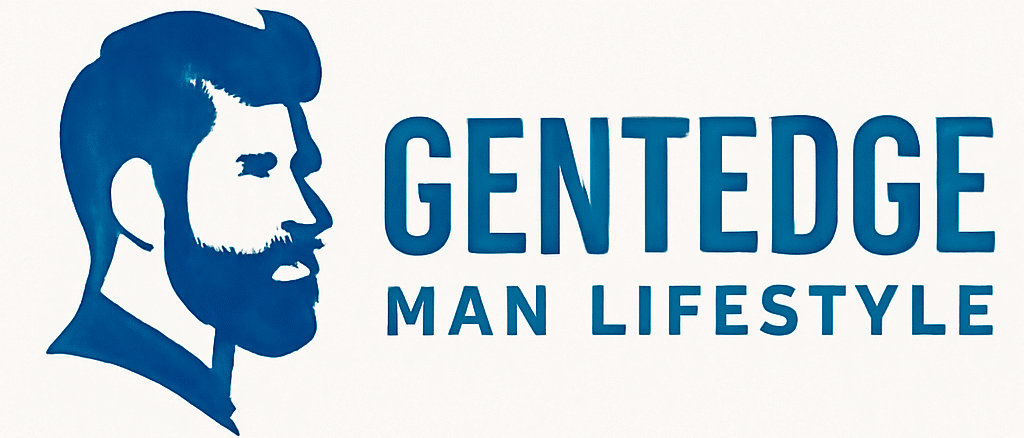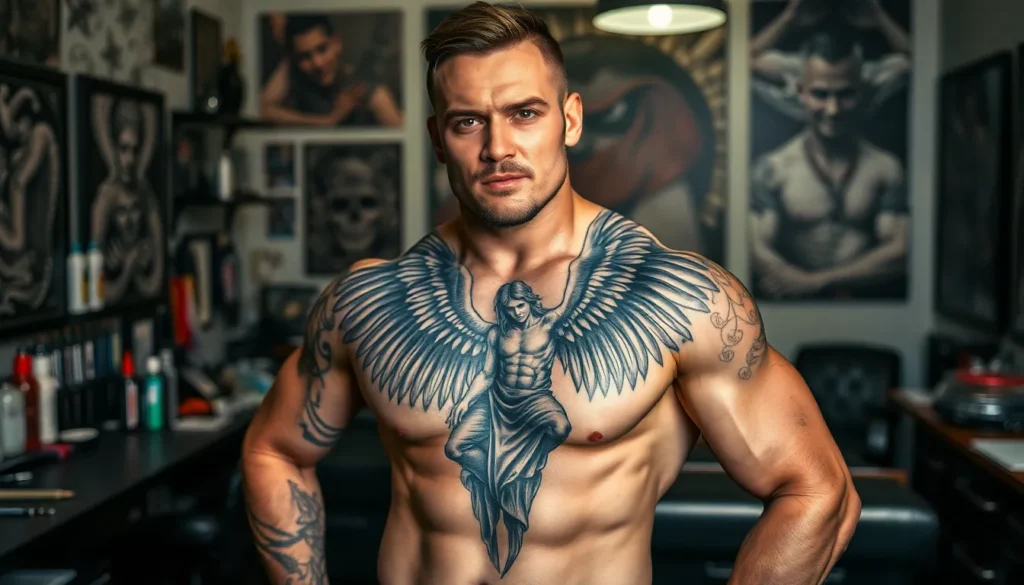Falling angel tattoos have become one of the most powerful and captivating designs in men’s body art. These dramatic pieces tell stories of struggle, redemption, and the eternal battle between light and darkness. We’ve seen countless men choose this striking imagery to represent their personal journeys, fallen heroes, or moments of transformation in their lives.
The symbolism behind falling angel tattoos runs deep – from representing lost innocence to celebrating the beauty found in our imperfections. Whether you’re drawn to the classical Renaissance-style depictions or prefer modern interpretations with bold shading and intricate details, these tattoos offer endless creative possibilities for meaningful self-expression.
We’ll explore the rich symbolism, popular design variations, and placement options that make falling angel tattoos such compelling choices for men seeking powerful body art. From small, minimalist designs to elaborate full-sleeve masterpieces, you’ll discover everything you need to know about this timeless tattoo style.
Classic Falling Angel Designs That Never Go Out of Style
These timeless designs have captivated men for decades, offering powerful visual narratives that transcend temporary trends. Each style brings its own distinctive elements while maintaining the core symbolism of angels in descent.
Traditional Lucifer Inspired Imagery
Lucifer themed tattoos draw from centuries of religious art and biblical storytelling. These designs typically feature a once majestic angel with elaborate wings, often partially torn or damaged, symbolizing the fall from grace. We see intricate details like flowing robes, detailed facial expressions showing anguish or defiance, and classical poses that mirror Renaissance paintings.
Common elements include horns beginning to emerge, a halo that’s cracked or falling away, and wings that transition from white to black. Many men choose these designs to represent personal struggles with temptation, the duality of human nature, or overcoming dark periods in their lives. The imagery often incorporates flames, shadowy backgrounds, or broken chains to enhance the narrative of rebellion and transformation.
Gothic Winged Figures in Descent
Gothic falling angels embrace darker aesthetics with dramatic architectural elements and medieval inspiration. These designs feature angels with weathered stone textures, ornate cathedral backgrounds, and intricate wing details that showcase gothic artistry. The figures often appear to be carved from stone or emerging from gothic structures like gargoyles coming to life.
Sharp contrasts between light and shadow define these compositions, creating depth and mystery. We notice elaborate clothing with flowing fabrics, detailed armor pieces, and gothic symbols like crosses, roses, or thorns woven throughout the design. The descent is often portrayed against cathedral spires, gothic arches, or crumbling stone walls that reinforce the medieval atmosphere.
Monochromatic Black and Gray Compositions
Black and gray falling angel tattoos offer timeless elegance through masterful shading and contrast work. These designs rely on skilled technique rather than color to create impact, using various shading methods to achieve depth and dimension. The monochromatic palette allows for subtle gradations that make the angel appear to emerge from the skin naturally.
Realistic rendering becomes the focus, with attention to anatomical accuracy, feather textures, and facial expressions that convey complex emotions. We see artists using techniques like stippling, cross hatching, and smooth gradients to create photorealistic effects. The absence of color forces viewers to focus on the composition’s emotional content and technical execution, making these designs particularly powerful for conveying personal meaning and artistic appreciation.
Modern Interpretations of Falling Angel Tattoos for Men
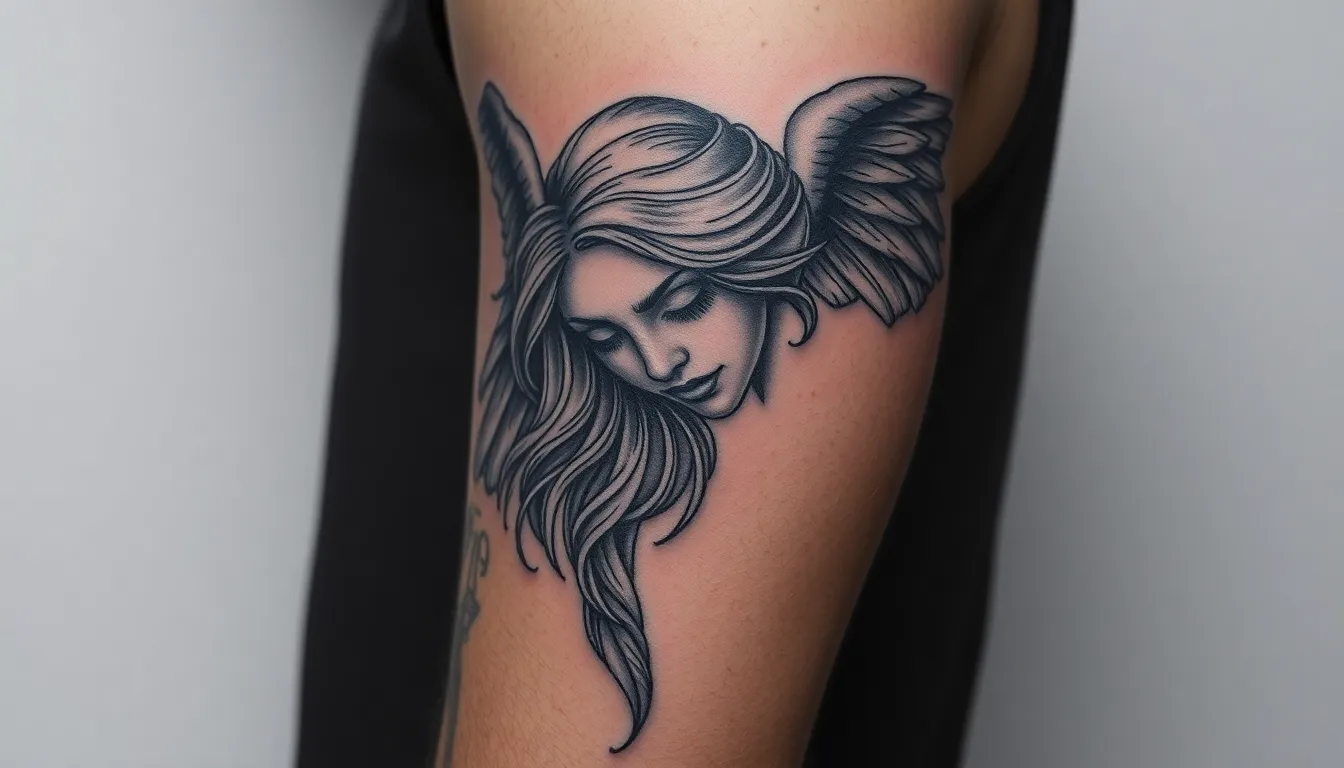
Today’s fallen angel tattoos embrace personal meaning and emotional depth while maintaining their powerful symbolism. Men increasingly choose these designs to reflect their own hardships, inner battles, or rebellious spirit, making each tattoo a statement of personal transformation and complexity.
Contemporary Artistic Styles and Techniques
Realism and black & grey techniques dominate contemporary fallen angel tattoo artistry. These styles emphasize lifelike, intricate details such as flowing hair, feathers, and expressive faces that highlight the tattoo’s emotional weight. Artists focus on creating photorealistic portrayals that capture every nuance of expression and texture.
Shading techniques in these realistic designs allow for incredible depth and dimension. Master tattoo artists use subtle gradations to create the illusion of three dimensional forms on skin. Fine line work defines individual feathers while careful attention to facial features brings the fallen angel to life.
Contemporary artists also incorporate mixed media elements into their designs. Some blend photorealistic portraits with abstract backgrounds or incorporate digital art influences. Others combine traditional tattooing methods with modern equipment to achieve unprecedented detail levels.
Minimalist Fallen Angel Concepts
Minimalist designs use simple lines, subtle shading, and negative space to convey the fallen angel theme with elegance and restraint. These tattoos often focus on silhouette or a single symbolic element like a wing or halo broken in design. Clean geometric shapes replace elaborate details while maintaining the core symbolism.
Single line drawings create powerful visual impact through their simplicity. Artists create entire fallen angel figures using continuous lines that flow seamlessly across the skin. Negative space becomes as important as the inked areas in these sophisticated designs.
Subtle dot work and fine stippling techniques add texture without overwhelming the minimalist aesthetic. Small accent elements like a single teardrop or cracked halo provide symbolic weight without cluttering the design. These restrained approaches appeal to men seeking meaningful tattoos with professional versatility.
Geometric and Abstract Angel Designs
Geometric styles incorporate angular shapes, sharp lines, and abstract forms to reinterpret the angel motif in a modern, stylized way. Abstract designs may use fragmented wings or surreal elements that blend the ethereal with a contemporary edge. Mathematical precision meets spiritual symbolism in these innovative interpretations.
Fractured wing patterns create stunning visual effects through strategic placement of geometric segments. Artists use triangular shapes, hexagons, and other polygons to construct recognizable angel forms. Sacred geometry principles often guide these designs, adding layers of meaning beyond the surface imagery.
Watercolor effects combined with geometric structures produce striking contrasts between organic and structured elements. Some designs feature partially geometric angels that transition into realistic portions, creating ever-changing visual tension. These modern approaches allow men to express their appreciation for both traditional symbolism and contemporary artistic innovation.
Symbolic Meanings Behind Falling Angel Tattoos
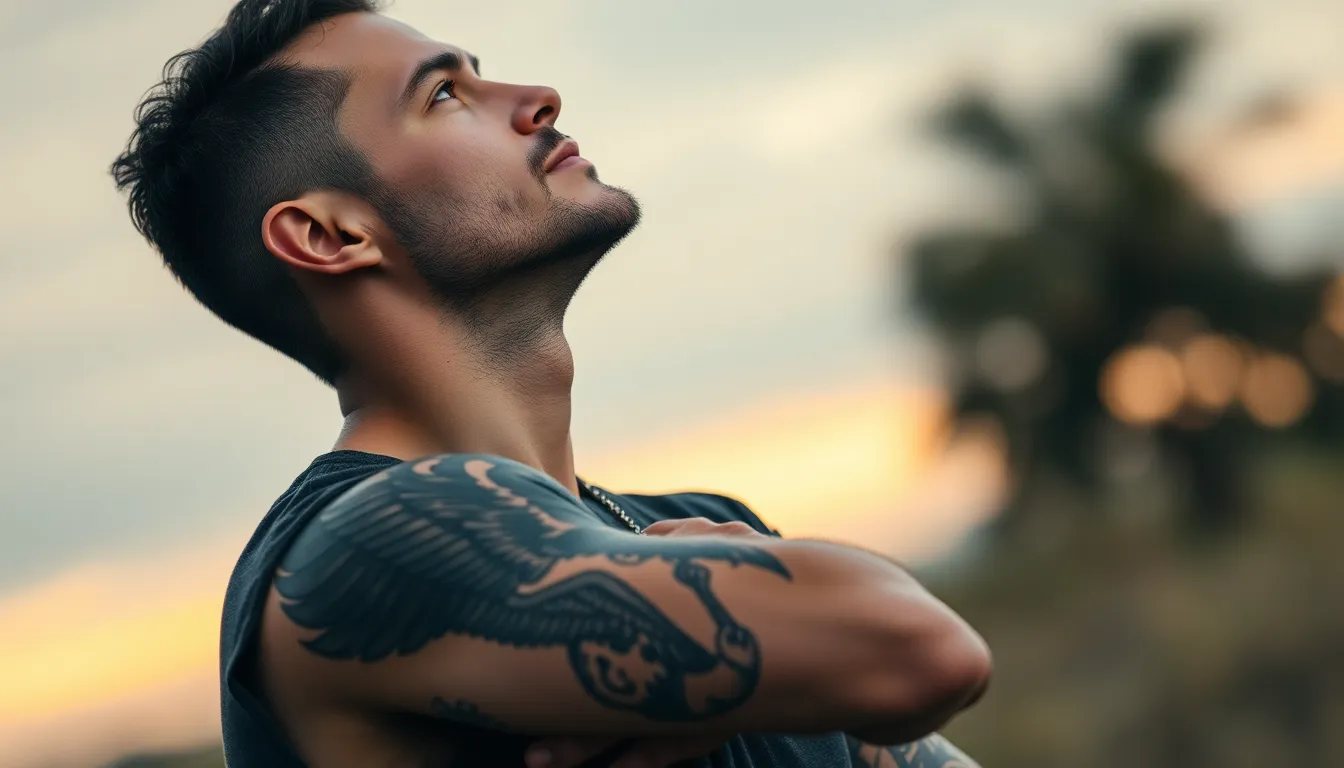
Behind every falling angel tattoo lies a profound narrative that speaks to the human condition. These powerful symbols carry multiple layers of meaning that resonate deeply with men seeking to express their personal journeys through body art.
Rebellion and Personal Freedom
Falling angel tattoos represent the ultimate act of defiance against authority and societal expectations. We see these designs as powerful emblems of personal freedom, echoing the biblical story of angels cast out of heaven for refusing to conform. Men choose these tattoos to symbolize their rejection of traditional norms and their willingness to embrace individuality, even when it comes at great personal cost.
The rebellious nature of the fallen angel speaks to those who’ve chosen their own path over acceptance. These tattoos celebrate the courage to stand against conformity and the strength to maintain one’s beliefs even though opposition. They serve as permanent reminders that true freedom often requires sacrifice and that choosing independence over security can be both liberating and challenging.
Overcoming Struggles and Adversity
Many men view the fallen angel as a metaphor for battling personal demons and emerging victorious from life’s darkest moments. These tattoos represent resilience in the face of addiction, grief, loss, and other important hardships that test human strength. We recognize them as symbols of survival and transformation through pain.
The imagery captures the essence of hitting rock bottom and finding the will to rise again. Men who’ve faced mental health challenges, relationship struggles, or career setbacks often connect with the fallen angel’s journey from grace to redemption. These tattoos serve as visual testaments to their ability to overcome adversity and emerge stronger from their trials.
Spiritual Transformation and Growth
Falling angel tattoos embody the complex nature of spiritual evolution and personal growth through struggle. We understand these designs as representations of the eternal tension between light and darkness within the human spirit. They symbolize the process of confronting inner conflicts and integrating both positive and negative aspects of one’s nature.
The spiritual significance extends beyond simple rebellion to cover themes of redemption and self awareness. These tattoos reflect the belief that true growth comes through facing one’s shadows and emerging with greater wisdom and understanding. Men choose these designs to mark pivotal moments in their spiritual journeys, celebrating the groundbreaking power of struggle and the beauty found in imperfection.
Best Body Placement Options for Falling Angel Tattoos
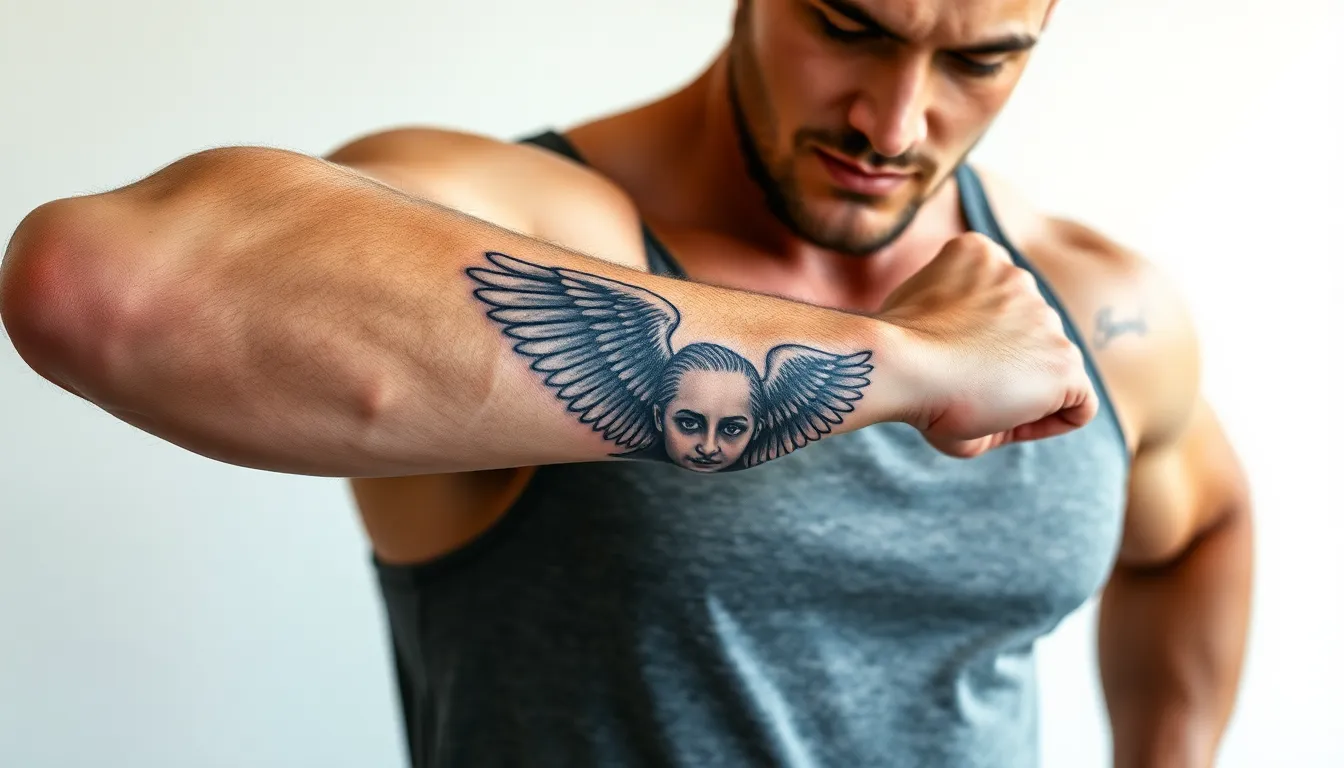
Selecting the perfect placement for your falling angel tattoo is crucial for maximizing both visual impact and personal meaning. We’ve identified the top locations that best showcase these powerful designs while considering factors like size, detail, and lifestyle needs.
Back and Shoulder Blade Positioning
Back placements offer the largest canvas for detailed falling angel artwork. The shoulder blade area provides an expansive surface that can accommodate complex designs with intricate wing details and dramatic poses. We recommend this location for men seeking maximum visual impact, as the broad space allows artists to capture every feather and expression with precision.
Concealment options make back tattoos highly versatile for professional settings. You can easily hide your falling angel design under clothing during work hours, then reveal it at appropriate social events. The upper back specifically excels at displaying angels combined with crosses or other symbolic elements, creating comprehensive religious or mythological narratives.
Pain levels remain moderate compared to other body areas. Most men find back tattooing sessions manageable, especially around the shoulder blade region where there’s sufficient muscle coverage. This makes it an excellent choice for first time recipients of large scale tattoo projects.
Chest and Ribcage Locations
Chest positioning creates intimate symbolism close to the heart. The broad, flat surface of the chest perfectly accommodates winged angel designs that can spread dramatically across the pectoral muscles. We often see men choose this placement to represent deeply personal struggles or spiritual transformations.
Ribcage tattoos provide vertical space for descent themed imagery. The elongated ribcage area works exceptionally well for falling angels captured mid plunge, creating ever-changing visual storytelling. But, we must note that ribcage sessions rank among the most painful tattooing experiences due to the proximity to bone and minimal muscle coverage.
Hiding capabilities remain excellent for professional environments. Both chest and ribcage tattoos stay completely concealed under standard business attire, making them ideal for men in conservative careers. The personal nature of these placements adds emotional weight to the design’s meaning.
Arm and Forearm Placements
Forearm locations rank as the most popular choice for falling angel tattoos. This placement provides sufficient surface area for detailed full angel figures while maintaining excellent visibility control. We recommend forearms for men who want the flexibility to display or conceal their tattoo depending on sleeve length.
Visibility balance makes arm placements highly practical. You can showcase your falling angel design in casual settings while easily covering it with long sleeves for formal occasions. The forearm’s natural shape complements the flowing lines of angel wings and robes.
Extension possibilities allow for comprehensive sleeve development. Starting with a falling angel on the forearm opens opportunities for expanding into full sleeve designs over time. We’ve seen many clients build thematic collections around their initial angel tattoo, creating cohesive arm pieces that tell complete stories through multiple sessions.
Pain tolerance remains moderate for most men. Arm tattooing generally causes less discomfort than ribcage or back work, making it suitable for tattoo newcomers. The muscle coverage in bicep and forearm areas provides adequate cushioning during the tattooing process.
Popular Falling Angel Tattoo Styles for Men
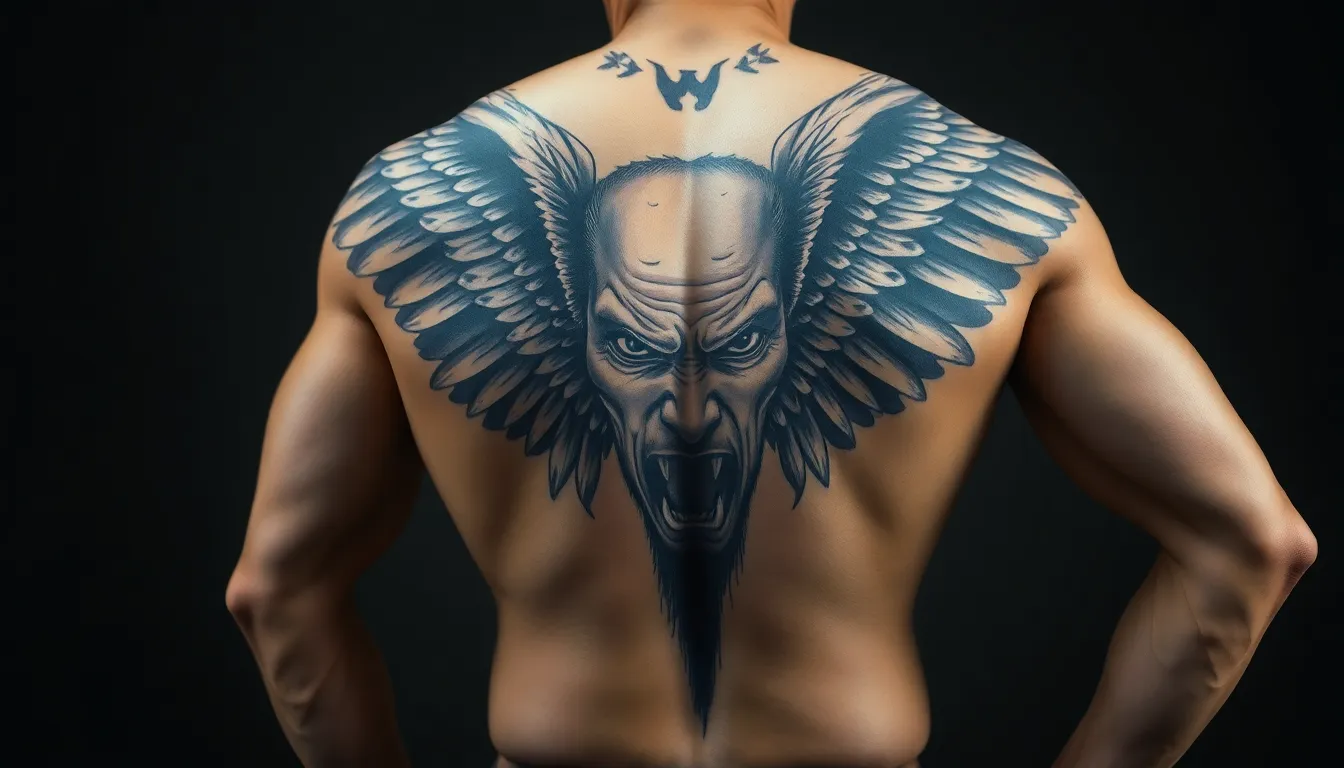
Contemporary falling angel tattoos for men showcase three distinct artistic approaches that transform this powerful symbol into compelling body art. Each style offers unique ways to express themes of rebellion, redemption, and spiritual transformation.
Realistic Portrait Techniques
Realistic falling angel tattoos emphasize intense, life-like detail that captures every nuance of emotion and anatomy. Artists use advanced black and gray shading techniques to create dramatic depth, focusing particularly on facial expressions that convey anguish, defiance, or contemplation. The muscular anatomy receives meticulous attention, with defined chest muscles, sculpted shoulders, and powerful wing structures that appear almost three-dimensional.
Ever-changing poses define this style, featuring angels in moments of descent, kneeling in despair, or caught mid-fall with wings spread wide. The emotional intensity becomes the centerpiece, with artists spending considerable time on features like tear-streaked faces, clenched fists, or eyes that reflect inner turmoil. This approach works exceptionally well on larger canvas areas like the back or chest, where the intricate details can be fully appreciated and the dramatic impact maximized.
Traditional American Style Interpretations
Traditional American falling angel tattoos embrace the classic Old School aesthetic with bold black outlines and a limited but vibrant color palette. These designs simplify the angel form into instantly recognizable shapes while maintaining powerful symbolic impact. The wings appear large and distinct, often featuring geometric patterns or flame-like edges that emphasize the fall from grace theme.
Symbolic elements play crucial roles in traditional interpretations, including flaming swords, broken halos, chains, or banners with meaningful text. Colors typically include deep reds, blues, and yellows that create strong contrast against the black outlines. This style appeals to men who appreciate classic tattoo aesthetics and want their falling angel to carry an immediately recognizable, timeless quality that connects to traditional tattooing heritage.
Neo-Traditional and New School Approaches
Neo-Traditional falling angel tattoos build upon classic foundations while incorporating richer color palettes and more sophisticated detail work. Artists maintain some bold outlines but introduce fluid line work, subtle gradients, and decorative elements like roses, geometric patterns, or celestial imagery. The angels often feature more realistic proportions than traditional styles while retaining the bold, graphic impact.
New School interpretations push creative boundaries even further with exaggerated features, cartoonish elements, and surreal themes that transform the fallen angel into highly personalized artwork. These designs might incorporate abstract backgrounds, impossible color combinations, or fantastical elements that blend reality with imagination. Both styles allow for extensive customization, enabling men to merge traditional symbolism with contemporary artistic expression that reflects their individual personality and story.
Design Elements That Enhance Falling Angel Tattoos
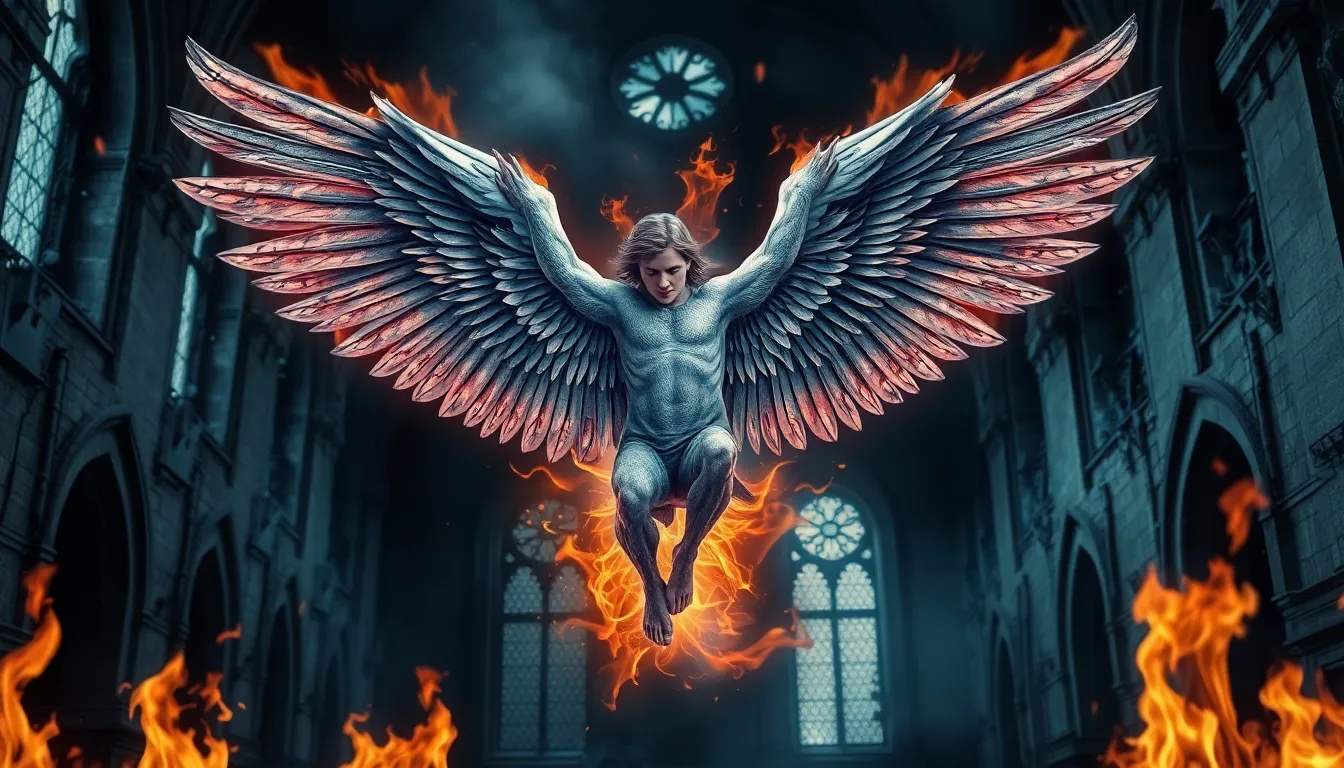
Creating compelling falling angel tattoos requires attention to exact design elements that amplify emotional impact and symbolic meaning. These key components work together to transform a simple angel figure into a powerful narrative of struggle and redemption.
Wing Details and Feather Textures
Wing composition serves as the centerpiece of any falling angel design, offering artists the opportunity to showcase intricate detail work that enhances the tattoo’s overall impact. We see feather textures ranging from soft and delicate strokes that preserve angelic purity to sharp and ragged elements that emphasize the fallen aesthetic. Artists frequently layer individual feathers with varying degrees of damage, creating visual storytelling through deteriorating plumage that mirrors the angel’s spiritual decline.
Realistic feather rendering requires careful attention to light and shadow placement, with each feather catching illumination differently to create depth and movement. Torn wing sections symbolize the loss of divine grace, while intact portions represent remaining hope or strength. Feather direction and flow guide the viewer’s eye throughout the composition, establishing the tattoo’s emotional rhythm and visual hierarchy.
Flames and Fire Imagery
Fire elements transform falling angel tattoos into ever-changing compositions that convey destruction, purification, and spiritual torment with striking visual intensity. We observe flames frequently surrounding the angel figure, symbolizing the burning away of innocence or descent into chaos that reinforces themes of divine punishment. These fire details add kinetic energy to static poses, creating movement that draws attention and enhances the tattoo’s dramatic appeal.
Flame placement varies strategically throughout successful designs, with some artists positioning fire at the wing tips to suggest burning feathers while others surround the entire figure in consuming heat. Color temperature becomes crucial in flame execution, with cooler blues and purples at the base transitioning to intense oranges and yellows at the peaks. Black and gray flame work relies on expert shading techniques to achieve the same visual impact without color, using contrast and texture to simulate heat and movement.
Architectural Backgrounds and Landscapes
Background elements provide essential context that transforms individual angel figures into complete narrative scenes with environmental storytelling power. We find crumbling gothic architecture particularly effective, with broken cathedral spires and weathered stone arches framing the fallen angel while suggesting lost paradise or spiritual exile. These architectural details create visual depth through perspective lines that guide attention toward the central figure.
Celestial landscapes offer alternative backdrop options, featuring cloud formations, distant mountain ranges, or abstract heavenly realms that contrast with the angel’s earthbound state. Urban decay settings resonate with modern interpretations, incorporating broken cityscapes or industrial elements that reflect contemporary struggles and societal disconnection. Ground elements like scattered debris, thorns, or barren earth beneath the angel’s form reinforce the fall from grace narrative while providing compositional balance to upward wing movement.
Color Schemes That Work Best for Men’s Falling Angel Tattoos
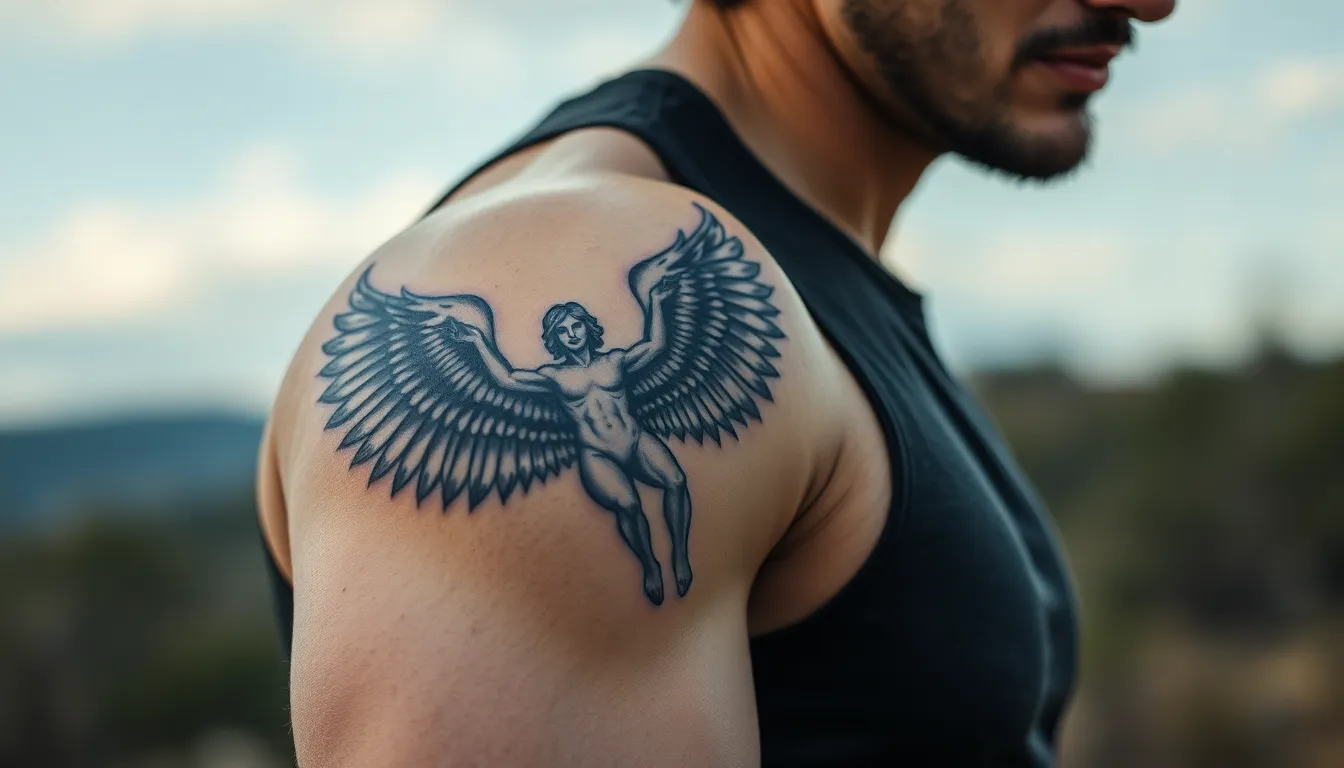
Color selection dramatically transforms the emotional impact and visual appeal of falling angel tattoos. We’ll explore three primary color approaches that enhance the symbolic power of these meaningful designs.
Bold Black and Gray Combinations
Black and gray remain the most popular choice for falling angel tattoos among men, offering unmatched versatility in artistic expression. These monochromatic schemes excel at emphasizing contrast and intricate shading techniques that bring out every detail in feathers, musculature, and facial expressions. Traditional black ink creates the deepest shadows while gray washes provide smooth transitions that enhance the three dimensional appearance of wings and drapery.
Artists frequently recommend this classic combination for muscular arms and broad backs where the dramatic contrast makes the strongest visual impact. Shading techniques using various gray tones allow tattoo artists to capture the somber, contemplative mood that defines the fallen angel narrative. Black outlines provide structure while gray fills create depth, making this color scheme ideal for clients seeking timeless appeal and professional versatility.
Dramatic Red and Orange Accents
Red and orange accents inject intense energy and emotional depth into falling angel designs, creating striking focal points that command attention. These fiery colors symbolize passion, pain, and the dramatic fall from grace itself, adding layers of meaning to the overall composition. Crimson highlights work exceptionally well on wing tips, clothing details, or background flames that frame the angel figure.
Orange tones complement red accents by providing warmth and intensity without overwhelming the design’s darker elements. Many men choose these bold color combinations to represent personal battles or groundbreaking life experiences, with the warm hues contrasting beautifully against black and gray foundations. Fire motifs and sun symbols become particularly striking when rendered in these ever-changing colors, creating tattoos that capture both destruction and renewal themes.
Subtle Blue and Purple Tones
Blue and purple tones introduce mystical and ethereal qualities that soften the falling angel’s appearance while maintaining emotional complexity. These cooler colors represent sorrow, spirituality, and the mysterious nature of celestial beings, creating a more contemplative artistic interpretation. Deep blues work particularly well in background elements and shadow areas, while purple accents can highlight clothing or create atmospheric effects.
Violet and indigo shades blend seamlessly with traditional black and gray work, adding subtle color without disrupting the tattoo’s classic appeal. These sophisticated color choices appeal to men seeking designs that convey spiritual depth and introspective meaning rather than aggressive symbolism. Night sky backgrounds and ethereal lighting effects become especially compelling when executed in these mysterious color palettes, creating tattoos that invite closer examination and contemplation.
Choosing the Right Tattoo Artist for Your Falling Angel Design
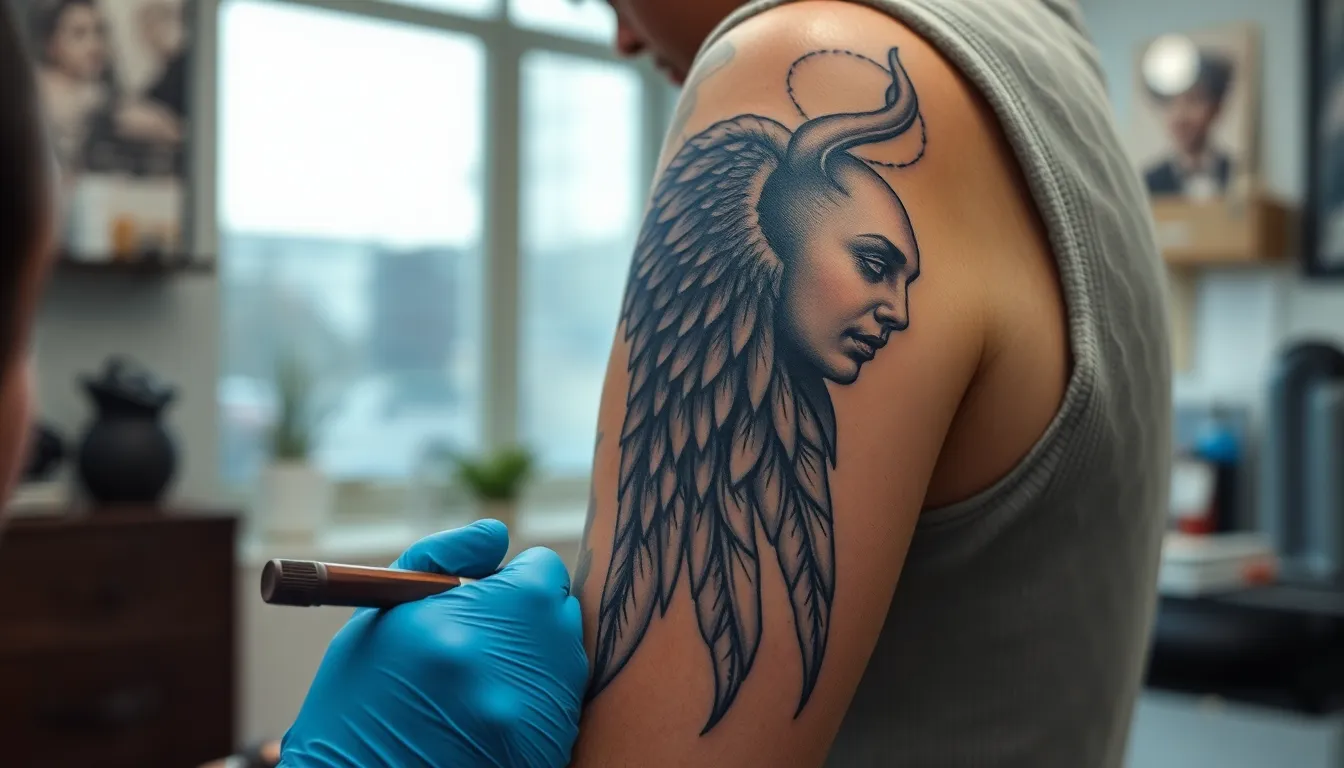
Finding the perfect artist to bring your falling angel vision to life requires careful research and evaluation. We’ll explore the key factors that separate exceptional tattoo artists from average ones when it comes to executing these complex, meaningful designs.
Researching Portfolio Specializations
Look for artists who specialize in detailed, realistic, and symbolic designs, particularly those with proven experience in angelic or mythological themes. Instagram and tattoo studio websites serve as excellent platforms for reviewing portfolios that showcase their ability to render complex shading and anatomical accuracy.
Examine their previous fallen angel work to assess how they handle intricate wing details, muscular forms, and expressive facial features. Artists who excel at these tattoos typically demonstrate mastery in capturing the emotional weight that makes fallen angel designs so compelling.
Focus on portfolios that feature similar symbolic elements like roses, celestial motifs, or geometric patterns combined with angelic figures. We recommend noting how they integrate multiple design components while maintaining visual cohesion and narrative strength.
Evaluating Technical Skill and Experience
Master-level fallen angel tattoos require proficiency in fine lines, detailed shading, and complex geometric elements. Artists skilled in black and grey realism or neo-traditional styles typically deliver the depth and dimension essential for these emotionally charged pieces.
Experience with larger tattoos becomes crucial since fallen angel designs often span important areas on arms, backs, or shoulders to capture the necessary detail and emotional impact. We suggest reviewing their portfolio for evidence of successful large-scale projects that maintain quality throughout.
Technical expertise in anatomical rendering separates exceptional artists from mediocre ones when depicting the human form of fallen angels. Look for smooth transitions between light and shadow, realistic muscle definition, and proportionate wing structures that complement the overall composition.
Consultation and Custom Design Process
Schedule an in-depth consultation to discuss your personal vision and symbolic preferences. Skilled artists collaborate with clients to customize designs that incorporate meaningful elements like exact angel poses, additional imagery such as roses or geometric patterns, and stylistic preferences that reflect individual stories.
Professional artists understand the deeper meanings behind fallen angel tattoos, including themes of rebellion, struggle, memorial significance, and spiritual transformation. We recommend choosing artists who respect these themes and can translate them authentically into compelling artwork.
Custom design development should involve multiple revisions to ensure the final piece captures both artistic excellence and personal significance. Artists who invest time in this collaborative process typically deliver tattoos that exceed expectations and provide lasting satisfaction.
Aftercare Tips for Large Falling Angel Tattoos
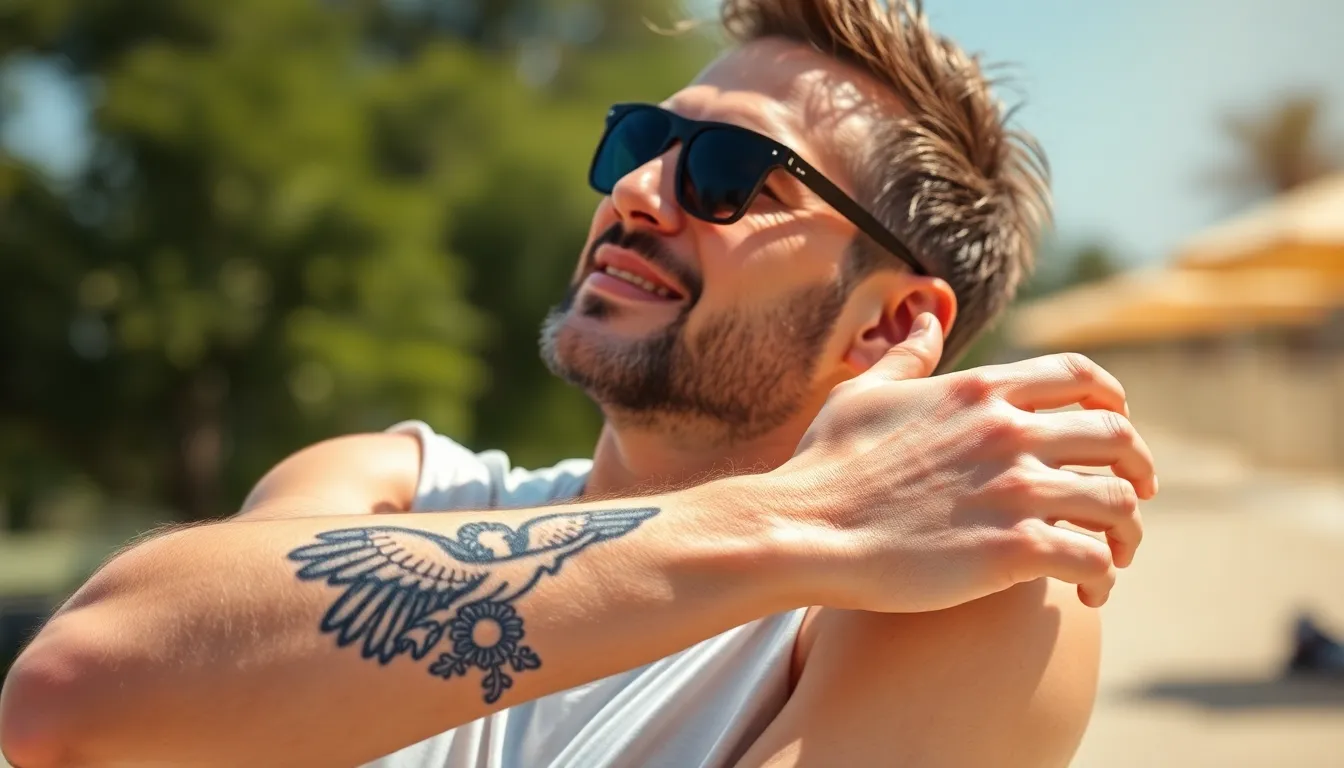
Large falling angel tattoos require dedicated care to preserve their intricate details and symbolic power. We’ll guide you through essential aftercare practices that protect your investment and maintain the tattoo’s visual impact.
Initial Healing Phase Guidelines
Keep your tattoo clean and dry during the first 2-3 weeks by washing gently with mild soap and lukewarm water. Patting the area dry with a clean towel prevents irritation and bacterial growth.
Avoid soaking the tattooed area in baths, pools, or hot tubs until complete healing occurs. Standing showers work best for maintaining hygiene without compromising the healing process.
Apply thin layers of recommended healing ointment or specialized tattoo aftercare lotion to keep skin moisturized. Over-applying products can clog pores and slow healing.
Resist scratching or picking at scabs that form during healing, as this behavior can cause infection and damage the ink’s precision. Gentle patting relieves itching without risking your tattoo’s integrity.
Protect from direct sunlight and avoid tight clothing that rubs against the fresh tattoo. Loose, breathable fabrics allow proper air circulation during the crucial healing phase.
Follow your tattoo artist’s exact instructions diligently, as they understand your tattoo’s unique requirements and healing characteristics.
Long-Term Maintenance Strategies
Moisturize the tattooed skin regularly using fragrance-free lotions to maintain vibrancy and prevent dryness that can dull the artwork. Daily moisturizing becomes part of your routine skin care.
Apply high-SPF sunscreen whenever the tattoo will be exposed to UV rays, as sun damage causes important fading over time. Broad-spectrum protection works best for preserving color intensity.
Maintain overall skin health through proper hydration and balanced nutrition that supports natural skin regeneration. Drinking adequate water and eating nutrient-rich foods benefit tattoo longevity.
Examine your tattoo periodically for changes in color, texture, or clarity that might indicate the need for professional attention or touch-up work.
Touch-Up and Refresh Considerations
Plan touch-ups several months after initial healing when you can accurately assess areas needing color restoration or line precision enhancement. Rushing this process compromises results.
Consult your original tattoo artist for personalized recommendations on timing and approach for refreshing your falling angel design. Their familiarity with your exact tattoo ensures consistency.
Expect touch-ups for detailed elements like feather textures and facial features that may soften over time, especially in large, intricate falling angel compositions.
Budget for maintenance sessions as part of your tattoo investment, understanding that preserving the symbolic depth and visual impact requires ongoing care and attention.
Conclusion
Falling angel tattoos represent more than just striking body art – they’re powerful statements of personal transformation and resilience. We’ve explored how these designs capture the eternal struggle between light and darkness that defines the human experience.
Whether you choose a classic black and gray composition or embrace modern geometric interpretations these tattoos offer endless possibilities for self-expression. The key lies in selecting the right artist who understands your vision and can bring the intricate details to life.
Remember that proper aftercare ensures your investment remains vibrant for years to come. With careful planning and dedication to maintenance your falling angel tattoo will continue telling your story of redemption and strength long after the ink has healed.
Frequently Asked Questions
What do falling angel tattoos symbolize for men?
Falling angel tattoos represent powerful themes of struggle, redemption, and the eternal conflict between light and darkness. They symbolize rebellion against authority, personal freedom, and the courage to stand against conformity. These tattoos also embody overcoming adversity, resilience in facing life’s challenges, and spiritual transformation, making them deeply meaningful expressions of personal journeys.
Where is the best placement for a falling angel tattoo?
The back and shoulder blade are ideal for detailed designs, offering versatility for professional concealment. The chest and ribcage provide intimate symbolism, while arm and forearm placements are popular for visibility and potential sleeve expansion. Each location varies in pain levels, with bony areas typically being more sensitive.
What are the most popular falling angel tattoo styles?
Three main styles dominate: realistic portrait techniques emphasizing life-like detail and emotional intensity; traditional American style with bold outlines and vibrant colors; and neo-traditional/new school approaches featuring richer colors and sophisticated details. Each style offers unique ways to express themes of rebellion, redemption, and transformation.
What design elements enhance falling angel tattoos?
Key elements include intricate wing composition with detailed feather textures, fire imagery representing destruction and purification, and architectural backgrounds like gothic structures or celestial landscapes. These components work together to transform a simple angel figure into a powerful narrative of struggle and spiritual journey.
What color schemes work best for falling angel tattoos?
Three primary approaches are effective: bold black and gray combinations for contrast and intricate shading; dramatic red and orange accents for energy and passion; and subtle blue and purple tones for mystical qualities and spiritual depth. Each scheme enhances the tattoo’s symbolic power and emotional expression.
How do I choose the right tattoo artist for a falling angel design?
Research artists specializing in detailed, realistic, and symbolic designs. Examine portfolios for technical skill, experience with larger tattoos, and ability to capture emotional depth. Schedule consultations to discuss your vision and symbolic preferences. This collaborative process ensures the final design reflects both artistic excellence and personal significance.
What aftercare is required for large falling angel tattoos?
Initial healing requires keeping the tattoo clean and dry, avoiding soaking, and applying healing ointments. Long-term maintenance involves regular moisturizing and sun protection to prevent fading. Plan for periodic touch-ups to maintain vibrancy, and consult your original artist for personalized care recommendations.
Are falling angel tattoos suitable for first-time tattoo recipients?
While falling angel tattoos can be meaningful first tattoos, they’re often large and detailed, requiring significant time and financial investment. Consider starting with a smaller design to test your pain tolerance and commitment. Ensure you’ve thoroughly researched the symbolism and chosen an experienced artist for best results.
